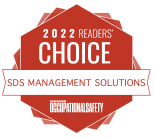
Chemical safety at work: a brief history and lessons for today
Chemical safety in the workplace has come a long way since the days of the “Radium Girls,” young women who developed cancer from painting watches and dials with radium-based paint in the early 1900s.
This occupational disease tragedy is a well-known example of dire health consequences born by workers when the risks of chemical hazards are unknown and safety precautions are not taken.
While there has been a great deal of progress over the past century to improve chemical safety in the workplace, there is still much to be done to keep workers safe and reverse occupational disease trends.
Soaring number of chemicals increases urgency for better safety solutions
In fact, there is as much urgency today, if not more so, for meaningful action to protect workers from chemical hazards.
The number of chemical products in use continues to explode, with thousands of new substances added to the Chemical Abstracts Service Registry every day, as the chart below shows:

Disease and death: catalysts for change
Unfortunately, too often it takes disease and even the death of workers like the Radium Girls to spur change.
In the early 1900s, radium was thought to be a successful cancer treatment and became known as a “health-tonic”. This naturally occurring radioactive material was added to food and cosmetics and even taken as an “energy” drink.
The factory workers were told that the radium paint was safe. They were instructed to put the paint brushes in their mouths to point the tips to paint the tiny numbers.
It was only when these women began to die of “radium jaw” that action was taken to protect workers from occupational disease.
This impetus eventually led to the creation of the first occupational health and safety act (OSHA) in the U.S. in 1970.
Below, we discuss other key milestones in the journey to improve chemical safety, and what’s needed today to go the rest of the distance to prevent occupational disease.
Key pillars of chemical safety
The World Health Organization describes chemical safety as follows:
“Chemical safety is achieved by undertaking all activities involving chemicals in such a way as to ensure the safety of human health and the environment.”
This encompasses “activities” involving both manufactured chemical products and natural chemical agents such as silica dust and even poison ivy.
Chemical safety is complex and requires scientific and technical knowledge as well as an understanding of the risk of biological and environmental harm, in order to properly mitigate the risk. Yet chemicals are pervasive and can be used by even the very young in projects such as building model airplanes, for example.
Progress on the risk mitigation front over the last century falls into three distinct eras, described below, as barriers to chemical safety awareness, knowledge and accessibility have been overcome.
Chemical Safety 1.0: an era of unknown risks, tragic consequences
As with the Radium Girls example above, an alarming rate of lung cancer and silicosis in uranium miners led to the first occupational health and safety act (OHSA) in Canada in 1978.
Things were changing, but this was still the “dark ages” of chemical safety, and oversight of chemical use in workplaces was virtually non-existent prior to 1988.
The early struggle for chemical safety knowledge
While OSHA and OHSA legislation placed heavy responsibilities on employers, information about the harms that workplace chemicals could pose was still very difficult to access, even as the number of chemicals in use in the workplace grew.
Employers and employees had little or no information on the potential health and environmental impact of products they used every day.
As a result, they depended on chemical safety experts to evaluate and summarize chemical hazards.
In this pre-Internet age, these chemical safety professionals had to do their research in libraries, combing through research papers, insurance reports and conducting their own experiments to determine the risks associated with the chemicals that were being used in workplaces.
This was particularly challenging and time consuming when there were numerous chemicals being used.
Another problem was that the harms from exposure often only become evident after the onset of latent occupational disease, such as with the Radium Girls and the uranium miners.
Chemical Safety 2.0: the introduction of WHMIS
A new era in chemical safety arrived in Canada with the introduction of the Workplace Hazardous Materials Information System (WHMIS) in 1988.
WHMIS 1988 required chemical suppliers to provide material safety data sheets (MSDSs) that centralized a lot of information about chemical products.
However, WHMIS MSDS documents still provided only vague information on the health-related impacts of chemical exposures. The health hazard information was grouped in one category called Class D (poisons and biohazards).
WHMIS also expanded employers’ duty to assess the hazards of chemical products and provide all workplace hazard information to joint health & safety committees (JHSCs), who would then communicate this information to workers and put workplace-specific safe-handling protocols in place.
This meant that employers continued to require chemical safety experts to assess and evaluate the risk of harm. Many small- and medium-sized businesses were unable to afford this expertise, even though they routinely use hundreds of chemical products.
The other big concern that surfaced was the considerable effort required by employers to source and update the WHMIS MSDSs and provide employee education.
During this era, occupational disease rates continued to rise, as confirmed by a study published in the National Library of Medicine.
WHMIS 2015 clarifies hazard information
With the ubiquity of chemical products used by everyone from children to the elderly and the extensive global trade in chemicals, the United Nations developed a new system called the Globally Harmonized System of Classification and Labelling of Chemicals (GHS) in 2002.
Canada adopted GHS in 2015 as WHMIS 2015, aiming to lower barriers to chemical safety. Workplaces were provided a transition period to comply with the new system, which ended in 2018.
WHMIS 2015 varies significantly from the 1988 version by putting the onus on chemical manufacturers, suppliers and distributors to conduct rigorous evaluations of their products for physical, health and environmental effects.
Safety data sheets replace MSDSs
WHMIS 2015 requires chemical suppliers to codify and convey this hazard information in a safety data sheet (SDS), a new document format that replaced the MSDS of WHMIS 1988.
If the process is done correctly, the resulting “labelling” of the hazards should enable any user to clearly understand the chemical safety symbols for potential harm associated with the product and to see general precautions to take to avoid harm.
Employer responsibilities: challenges remain
While WHMIS 2015 has improved awareness of chemical safety, it has not yet had the desired impact.
Many employers believe that if they have an SDS binder - paper or electronic - and provide basic WHMIS education, they have done what’s required to protect workers from chemical hazards.
In fact, the presence of SDS binders in a workplace doesn’t move the needle on employee health and safety outcomes.
Preventing chemical risks to employees
Employees are still at high risk of illness, disease and death, and employers are at risk of fines and lawsuits, because it is extremely difficult to use traditional, manual processes to comply with the intent of WHMIS and reach chemical safety goals due to the large amounts of data involved.
For example, WHMIS 2015 requires employers to identify and evaluate the hazards of chemical products used in their workplace (risk assessment) to ensure that the recommended precautions for safe chemical handling are available to workers.
This is a huge job given the average workplace has 100 chemical products on site and there are more than 100 different types of hazards codified in WHMIS 2015.
SDS information overload: how to find the needle in a haystack?
Consider the task if an employee has a severe reaction to a chemical ingredient like an isocyanate.
To oversee their safety, the safety officer must review approximately 100 SDSs (about 1,500 pages total) in order to determine which products contain isocyanate.
Or consider if a pregnant employee asks which chemical products may be harmful to the unborn child. Again you must review 1,500 pages to look for reproductive toxicants, and so on.
On top of that, the safety officer must cross-reference the 1,500 pages to the jurisdictional regulations for over 800 ingredients with occupational exposure limits.
Communicating current SDS information
Employers must also communicate this chemical hazard information to everyone in their organization and ensure up-to-date safety data sheets are accessible 24/7/365.
Providing job specific chemical hazard training
And employers must provide job-specific training on the safe use of products in workplace-specific situations (general WHMIS education is not enough).
Keeping SDSs up to date
OHS leaders who manage more than 100 chemical products find simply keeping safety data sheets up to date is a huge administrative burden with little or no time left over for other important chemical safety initiatives.
It's easy to imagine how OHS leaders can become overwhelmed and how unsustainable this approach to chemical safety is, even with the help of file search features in the case of electronic SDSs.
Another big challenge is the sheer volume of information that workers are currently required to digest to be safe on the job. Imagine trying to read and remember the information in a 15-page SDS for each of the 100 or so products in your workplace!
Towards Chemical Safety 3.0
Overcoming the challenges listed above is the key to reaching a third era in chemical safety, where employees have real-time info to assess chemical safety risk, implement controls and proceed with their work.
Software is the only possible means of digesting and responding to the ever-growing amount of chemical safety data in order to answer employee questions and make decisions in a timely manner.
SDS RiskAssist software makes hazard info accessible and actionable
We developed SDS RiskAssist software to overcome the remaining barriers to keeping workers (and the environment) safe from exposure to harmful chemicals.
It is the only SDS management software system that makes critical chemical hazard information easily accessible and actionable for a safe, sustainable, fully WHMIS-compliant workplace.
There’s no more searching through pages and pages of SDSs for key information, no more time-consuming research, and no more worry that employees won’t be able to find the information they need, when they need it, to stay safe.
SDS RiskAssist provides all critical information for each chemical product at a glance on simple one-page SafetySnap™ summaries, accessible 24/7/365 on any smartphone, tablet or desktop device.
The software takes the information declared by the supplier in the SDS, cross-references it against regulations and best practices and prioritizes the safety actions required, including allowing OHS leaders to automate custom safe-handling directives for all chemicals in use.
Tech tools key to chemical safety in a fast-changing world
The world is changing fast. Research on chemicals is also changing fast and is expected to increase still more with the introduction of OpenAI.
The key to harnessing all this information in any industry is to extract the relevant data and organize it into a usable, sustainable context, at scale.
Our vision at SDS RiskAssist is to enable every person handling chemicals to understand the hazards and be prepared to protect themselves, those around them and the environment.
By leveraging technology, we can take meaningful, necessary action to PREVENT future workplace exposures and avoid the painful consequences, including childhood diseases, cancer, heart disease and environmental harms, for new generations to come.
Need help with a chemical safety issue at work? Please reach out to us! We're here to help.
Also see our:
Guide to Chemical Safety Compliance
Free Occupational Exposure Limit (OEL) tool












